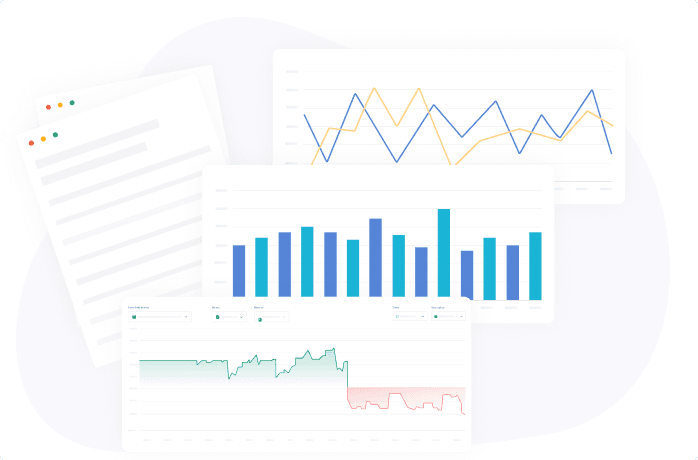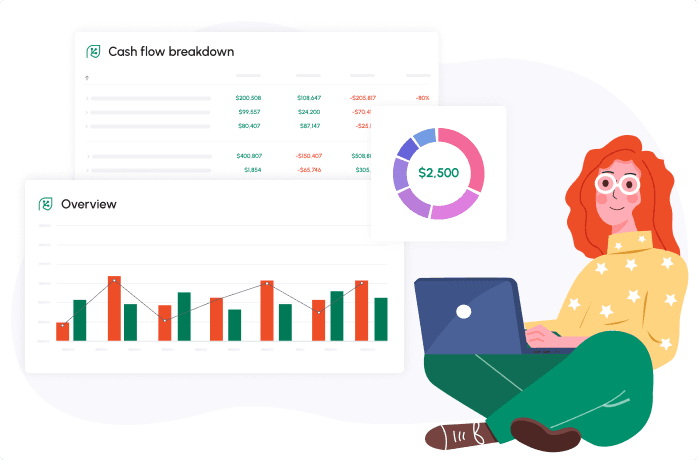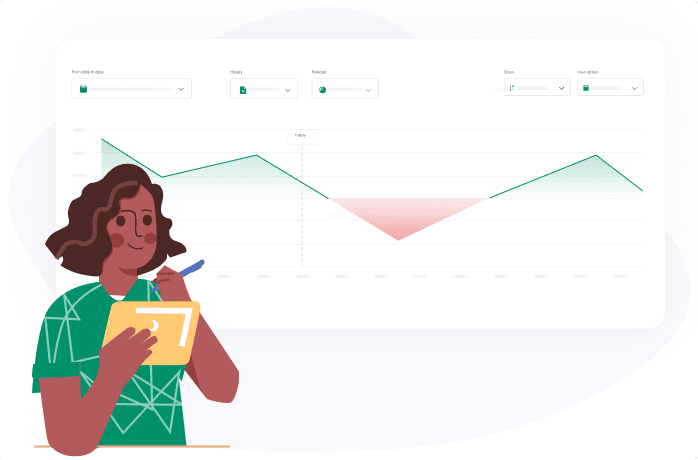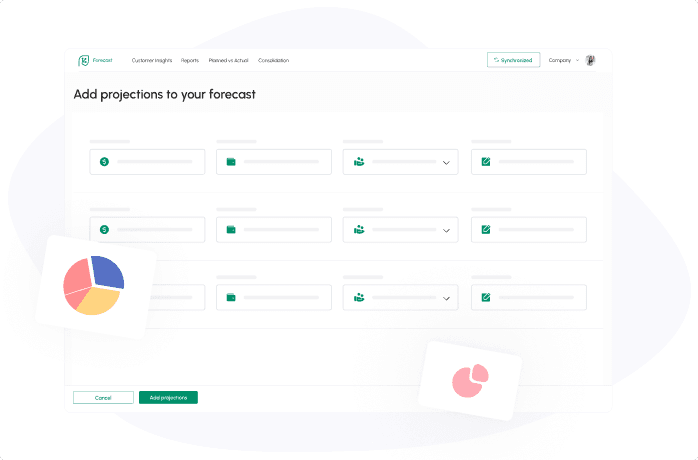

If you operate a business, you know that there’s a time between your investments and when these investments turn into cash. Your operating cycle is unique, yet you can use a cash conversion cycle formula to understand the average time it takes for you to be paid.
In this guide, we’re going to answer a few questions:
- What is an operating cycle?
- What is the cash conversion cycle?
- How to calculate your cycles?
We'll also reveal five key ways that you can improve cash cycles so that you can convert potential cash to cash faster.
What Is a Cash Conversion Cycle?
The cash conversion cycle (CCC) is a way to measure how long it takes for your company to turn investments into cash flow. Investments, in this sense, are often purchasing inventory or materials.
CCC is measured in days, and you may find CCC defined as:
- Cash flow cycle
- Simple cash cycle
- Operating cycle
However, all of these names refer to the time that your business’ money is tied up before it converts to cash. Your potential cash to cash cycle may be 20 days if you purchase a piece of inventory that then sells in 20 days. There are some nuances here, such as also accounting for the time it takes to collect on receivables
As a quantitative measure, the operating cycle formula is one that sheds light on your business’:
- Efficiency
- Sales process
- Management
Now that you understand the CCC, it’s time to learn how to calculate cash conversion cycle.
How to Calculate Your Cash Conversion Cycle
The CCC has a lot of parts – three, to be precise.
- Days of inventory outstanding
- Days of sales outstanding
- Days payables outstanding
The cash conversion cycle formula is: DIO + DSO – DPO. However, you need to know how to calculate DIO, DSO and DPO before you can even begin.
Calculate Days Inventory Outstanding (DIO)
DIO calculation, also frequently referred to as days sales of inventory (DSI), requires you to know the following:
- Average inventory
- Cost of goods sold (COGS)
Your average inventory is calculated based on your beginning inventory and ending inventory using the following calculation (.5 * (BI + EI)). With this in mind, you would then calculate your DIO with the following formula:
- (Average inventory / COGS) * reporting period
For example, let’s assume that you use a 90-day reporting period. You may have:
- Beginning inventory of 100000
- Ending inventory of 35000
- Average inventory of (.5 * (100000 + 35000)) = 67500
- COGS of $10000
Now, your DIO would be (67500/10000) * 90 = 607.5.
Calculate Days Sales Outstanding (DSO)
Next in the cash to cash cycle formula is calculating your DSO, which is a metric that businesses use to understand the length of time it takes to collect cash from sales.
It's always best to have a low DSO because it’s an indication that your sales department is running optimally and can collect on sales rapidly.
This cash cycle formula requires you to know:
- Average accounts receivable
- Revenue per day
- Beginning accounts receivable (BAR)
- Ending accounts receivable (EAR)
Just like with DSO, we need to determine the average by using the following calculation: Avg AR = (0.5 * (BAR + EAR)).
Once you have this information, you will then use the DSO formula, which is (Avg AR / Revenue Per Day).
For example, let’s assume the following:
- BAR = 10000
- EAR = 3000
- Avg AR = (0.5 * (10000 + 3000)) = $6,500
- Revenue per day = (20000 / 90) = $222.22
The 90 in the last calculation is for the 90-day reporting period, but it can also be 365 or whatever period that you would like. Putting this all together, DSO = (6500 / 222.22) = 29.25
Calculate Days Payables Outstanding (DPO)
DPO is the final calculation that you’ll need to run before you can calculate operating cycle periods. A higher DPO is optimal here, but you’ll need to have a lot of data to run this operating cycle calculation.
- Beginning accounts payable (BAP)
- Ending accounts payable (EAP)
You’ll use a very similar formula to the previous one to determine the Avg Accounts Payable = (0.5 * (BAP + EAP)). Let's assume that you have the following:
- BAP = 10000
- EAP = 1000
- Avg AP = (0.5 * (10000 + 1000)) = 5050
- COGS Per Day = (3000 / 90) = 33.33
In this case, 3000 is the cost of goods (it can be any figure) for the accounting period of 90 days.
You'll then run the final calculation of DPO = (5050 / 33.33) = 151.5.
Finally, with all of this information on hand, we can look at an example of a cash conversion cycle calculation.
Calculate Your CCC (An Example)
The cash conversion cycle formula is simple to follow, but it’s important to see a real example of how this works. We’ll be using the figures from the previous examples to fill out the CCC formula, which is DIO + DSO – DPO.
Based on the figures above, the formula would be = 607.5 + 29.25 - 151.5 = 485.25.
What is operating cycle?
It's a metric that you can use to better run your business and understand its financial health. However, you need to use this information to better grow and optimize your operations. Your CCC can tell you about your company’s:
- Inventory levels and if they’re too high or too low
- Expense payments and if they occur too quickly
- Inventory forecasting precision
- Overall business health
- Efficiency
What’s a Quality Cash Conversion Cycle?
Unfortunately, every business and industry will have its own CCC. Most businesses will not divulge these figures to competitors, so it can be difficult to know if you have a quality CCC or not. The one thing to know is that the shorter cash to cash cycle time, the better.
Every business should spend time to bring CCC as close to 1 as possible.
When you have a CCC of 1, this means that you have a very liquid business and don’t have capital that is tied up in your accounts receivable. You can even have negative CCC.
What is Cash Conversion Cycle Negative?
Negative CCC is the best type of sales you can have because this means that the goods are paid for before you even purchase inventory. For example, you can have a negative cash flow conversion when you have a presale.
Let’s assume that 10,000 people pre-order your upcoming jacket. In this case, your CCC may be negative because people paid for your goods before they were even made.
Improve Cash Flow Management
Cash flow management is often more important than knowing how to calculate operating cycle. One of the proven methods of cash flow management is to automate your accounts receivable. For example, you can:
- Send invoices automatically
- Send invoice reminders
- Notify HR of late payments
Automation should be used whenever possible as a way to help with cash flow management. The goal is to reduce the need for human intervention to do mundane tasks, such as spending time sending invoices.
When an automated system is in place, it will ensure that customers receive their invoices promptly. The use of automation also frees up the worker’s time, allowing them to spend more time on core tasks.
What Can Companies Do to Improve Cash Conversion Cycle Times?
Reducing CCC is an initiative that business owners and leaders should undertake this year. With the help of automation and software, it’s easier than ever before to reduce CCC. You can even use an operating cycle calculator to monitor your process in improving cash conversion cycle.
The following tips will help you lower CCC time and improve the odds that you receive your money faster.
1. Invest in Real-Time Analytics
You know what a cash conversion cycle is, but “what is cash conversion cycle in real-time?” Companies do not have the resources to have someone in-house run these calculations all day as sales come in and inventory is purchased.
Instead, you can invest in real-time analytics to help you better understand your CCC at any given time.
For example, let’s assume that you use a quarterly CCC of 90 days. You may have a CCC of 4 during this period, but for the first month, your CCC may have been 25. Rapid payments near the end of the quarter can mask this major issue.
Real-time analytics allow you to:
- Make data-driven business decisions
- Adjust your AR plan to meet your business’ needs
With the help of real-time data, you’ll often see an initial trajectory where your CCC is higher than expected and then, if management makes adjustments, you’ll have the opportunity to watch your CCC begin to drop.
Many solutions are available to provide you with analytics that you can use to monitor CCC without having to worry about complicated formulas and calculations.
2. Encourage Earlier Payments
CCC may be high because of slow payments. If you’re a B2B company, you know that paying debts quickly can cause liquidity problems. Instead, many businesses will wait until the invoice due date to make payments because they want to keep the money in their accounts.
However, this scenario above will cause your CCC to rise. One way of dealing with this problem is to encourage earlier payments. Early payments can be encouraged in multiple ways, including:
- Discounts. If you want to receive payments faster than normal, you need to offer a discount. Even a 1% discount on a high invoice for a quick payment will entice your customers to pay faster. Businesses want to save money, and a discount for a fast payment is often more than enough to stop late invoice payments from occurring.
- Delivery promises. Do you work with a customer or major account that needs to have products fast? In this case, you can offer them faster delivery terms if they pay in full, pay ahead of time or guarantee that they’ll pay on time.
- Incentivize fast payments. You can offer incentives for anyone who pays on time routinely. For example, you could offer a 5% discount for customers who have been paying on time for the past six months. Additionally, you can extend credit terms to customers who order often and pay on time.
Now, the next tip is one of the most difficult for businesses, but it’s a great tactic for improving customer satisfaction and CCC.
3. Speed Up the Delivery Time
If you deliver products faster, the reduction in time for delivery can also reduce payment terms. For example, let’s assume that you normally deliver goods within a month of the order being placed. In this case, you may work to reduce delivery to two weeks.
In this scenario, you can send invoices faster and receive payments two weeks earlier than normal.
Providing faster delivery times will help your business in numerous ways, including but not limited to:
- Improve your customer relationships
- Increase customer retention
- Make paying your business a priority
Of course, if faster deliveries cause your profit margins to shrink, you’ll need to analyze the benefit for your business. With that said, you may also learn about new, exciting ways to use technology, automation or new processes to produce and deliver goods faster than average.
4. Make It Easier to Pay
How do you accept customer payments? Did you know that 80% of customers prefer using credit over cash? Some companies may even want to pay via cryptocurrency or check. You should do everything in your power to:
- Accept as many forms of payment as possible
- Make it as easy for customers to pay as you can
You can make it easy for customers to pay in a few ways:
- Allow for online payments
- Allow for in-person payments
- Accept automatic payments
- Accept payments via PayPal, Stripe, etc.
If you have customers come into your office often, you can also accept mobile payments. When you’re in the middle of a deal, mobile payments will allow customers to pay you ahead of time.
Remove as many barriers as you can during the payment process, and you’ll notice that your CCC starts to fall.
5. Simplify Your Invoices
Finally, simplify your invoices. If you’re still sending invoices manually, you want to find ways to automate this process. Invoices may not seem complicated, but imagine the following scenario:
- You send a customer goods on Monday at 3 pm
- Human resources send out invoices on Monday morning
- You need to wait 7 days before sending the customer an invoice
The above system is very inefficient and will not allow customers to pay you in a timely manner. Instead, you’ll want to do a few things. First, make the invoices as simple as possible so that customers can read the invoice and never have questions. Next, use an automation system that sends invoices out automatically, saving you manhours on sending invoices and also reducing the time it takes to receive payment.
In fact, automation can play a major role in your operations.
What Role Does Automation Play in CCC Improvement?
Automation can help your business in numerous ways:
- Instead of running calculations manually, you can use a cash conversion cycle calculator that gathers all of the data for you and saves time on reports.
- Cash conversion ratio and other metrics can be presented and put into reports to make it easier for finance teams and CFOs to understand the business’ health.
- Automation can send out invoice reminders and track down late payments without the need for human intervention.
Automation can help your business reduce the time it takes to be paid for goods, shortening the cash conversion cycle in the process. You can also reduce the necessity for key team members to spend unnecessary time on tasks that can be automated, such as sending invoice reminders to improve payment time.
Related posts:
You may be interested:
New:













